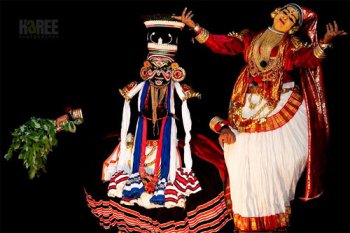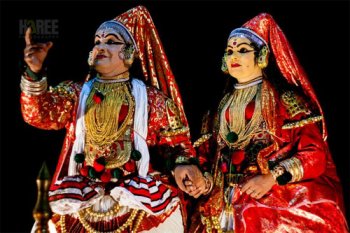
|   |

|   |
A memorable Lalitha Text & pics: Hareesh N Nampoothiri e-mail: newn.haree@gmail.com August 29, 2013 Kaliyarangu, an organization registered for promoting classical art forms, staged an evening Kathakali program recently in Thiruvananthapuram. Selected scenes in which demoness Simhika approaches Panchali taking the form of a damsel named Ganika (Lalitha, as the character form is mentioned in Kathakali), from Kottayam Thampuran’s ‘Kirmeera Vadham’ was staged during the event. The episode starts with Simhika waiting for her husband Sardoola, who is out in search of food. She waits for long but there’s no sign of Sardoola and she sets out searching for him. Upon getting the smell of humans, she follows the path and overhears the sages talking about how Arjuna killed Sardoola and saved their lives. She decides to take revenge by abducting the Pandava’s wife and approaches a lonely Panchali disguised as the beauteous Ganika 

Margi Vijayakumar, a pioneer in presenting Lalitha, did the role to perfection. Lalitha starts off praising the beauty of Panchali in an attempt to win her confidence. It is a challenge for any actor who portrays the character, as all these sweet words come from a vindictive Simhika who hides her real intentions for the time being. Margi Vijayakumar managed to do this by the efficient use of well controlled sancharis. With a sense of appropriate timing, Vijayakumar successfully displayed glimpses of evil shades hidden behind the smiling face of Lalitha. On the other hand, it was a pretty ordinary attempt from Haripriya Namboothiri who portrayed Panchali. Her act was rather unconvincing and to make it worse she was watching her co-artist for most of the time instead of facing the audience. At the end, mesmerized by the words of Lalitha, Panchali decides to follow her to the depths of the forest. “Kandalathimodam,” the next padam of Lalitha set in Kamboji describes the beauty of the dense forest. The padam gives an opportunity not only for the actor, but also to the vocalists and percussionists to excel. Kottakkal Narayanan, the main singer, was at his best, well supported by Kalanilayam Rajeevan. The final stanza was rendered in Kapi, which was a welcome change to end the padam. Kalamandalam Hari’s splendid effort on maddalam was delightful. Not only that he produced sound effects of beetles and koel in maddalam but also fluently followed the steps and mudras of the actors throughout the performance. Maddalam got prominence in this part of the play and it was only a routine job for Kalamandalam Thampi in chenda. Once Panchali realizes that she's in trouble, she cries for help and Sahadeva comes to her rescue. Simhika transforms back to her original form and challenges Sahadeva only to get mutilated by him. Towards the end, there is nothing much to do for the actors who present the Penkari form of Simhika and Sahadeva. Kalamandalam Balakrishnan and Kalalayam Arjun Subrahmanian were the actors who handled these roles. Unfortunately, I couldn't watch the initial portrayal of Kalamandalam Balakrishnan as Simhika (referred to as Karivattam in Kathakali) and so I am reserving any comments on his presentation. For a young actor like Arjun Subrahmanian, these stages are important to build confidence and he made good use of it. The play was presented by Vallathol Smaraka Kathakali Yogam, Margi Ravikumar taking care of chutti. Hareesh N Nampoothiri is a visual design consultant by profession and a lover of classical art forms. Being an ardent follower of Kathakali, he conceptualized and directed a documentary on Kathakali titled 'Thouryathrikam,' which introduces the nuances of Kathakali to the common man. Writing and photography are his other passions. |